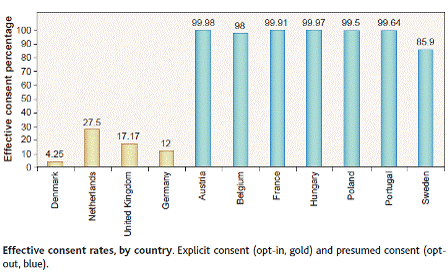Across the world, tens of thousands of people die each year as a result of not being able to find a suitable organ donor for their ailment. An oft-cited Gallup poll showed that although over 85% of US Citizens approved of the concept of organ donation, only 28% had signed the donor card. This pattern of behavior was also recorded in other European countries, and in a 2003 paper Professors Eric J. Johnson and Daniel Goldstein of the Center for Decision Sciences at Columbia University set out to discover why.
Johnson and Goldstein researched organ donation rates in 11 countries, and while some had pathetically low donor consent rates of 4.25%, others had stratospherically high donor consent rates of 99.98%! Even when the researchers accounted for country by country differences in transplant infrastructure, education, religion, and economics, these huge divisions persisted, accounting for a 2,352% difference between the high and low participation countries!
What was the primary cause of this vast divide in donor rates? The answer lies in the default option!
 In the countries studied, there were two applicable organ donor regimes: presumed consent and explicit consent. In presumed consent, everyone was an organ donor unless they opted out of being one. In explicit consent, no one was presumed to be an organ donor unless they explicitly opted in.
In the countries studied, there were two applicable organ donor regimes: presumed consent and explicit consent. In presumed consent, everyone was an organ donor unless they opted out of being one. In explicit consent, no one was presumed to be an organ donor unless they explicitly opted in.
The researchers believe that default options have such strong power because:
- The default option is believed to be the recommended policy of the policy maker and therefore conveys authority
- Making an alternate decision involves “cognitive complexity” and extra effort, whereas simply accepting the default does not
- The hassle of filling out a form to change the default is often not worth it
- The default option is viewed as the current (accepted) status quo, and any change to it may be perceived as incurring some type of loss
The researchers also studied this phenomenon with their own experiment. 161 test subjects were asked about their donor choice in one of three conditions:
- You have just moved to a new state where the default is not to be an organ donor. Will you confirm or change that status? (Opt-in condition)
- You have just moved to a new state where the default is to be an organ donor. Will you confirm or change that status? (Opt out condition)
- The third condition was a neutral one where no default option was presented. The subject had to explicitly choose to opt in or opt out.
Once again, the results proved the awesome power of default options …
Once again, the results proved the awesome power of default options with almost twice as many (82%) people choosing to be organ donors when it was the default option than when it was not (42%). But as a testament to people’s desire to do the right thing, 79% of people chose to donate when neither option was presented as the default.
Numerous other studies have also been conducted on such things as insurance policies, pension plans, and internet browser choices and all have re-affirmed the power of the default choice!
Install a default option mechanism in your sales process, and watch your conversion and upsell rates rise! Here are some ways that other companies are already doing it:
- Selling new cars? Offer default option packages. “This new BMW already comes with the Technology and Convenience package.”
- Want to make sure people use your search engine? Strike deals with the browser publishers to have their software pre-set to use your search engine!
- Want to sell more software? Have it “pre-loaded” on that new Dell laptop.
Want to increase your persuasiveness? Set up your automatic defaults!
![]()
 by
by 